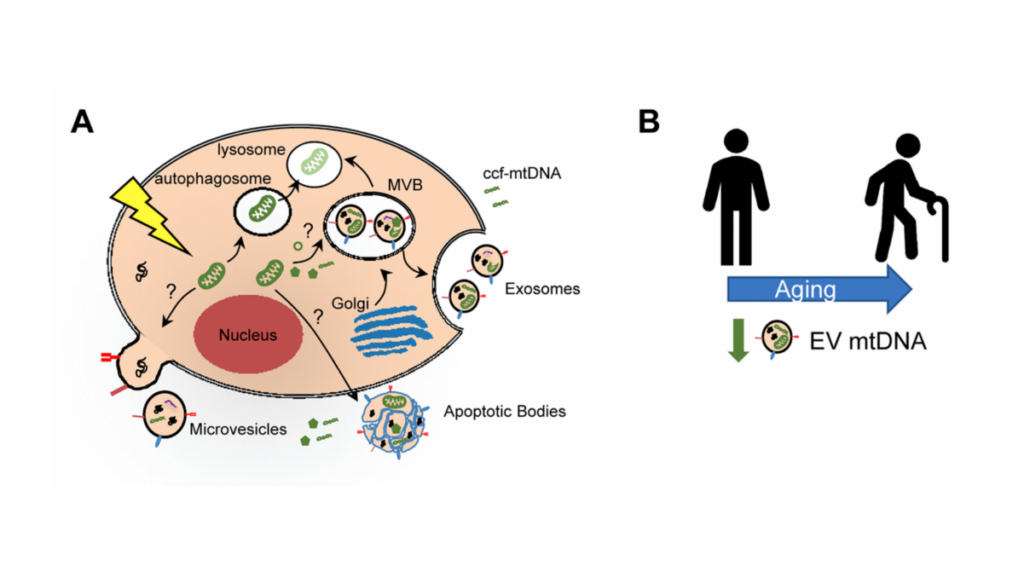Authors from the National Institute on Aging wrote a trending editorial paper on mitochondria extracellular vesicles and aging.

The Trending With Impact series highlights Aging publications that attract higher visibility among readers around the world online, in the news, and on social media—beyond normal readership levels. Look for future science news about the latest trending publications here, and at Aging-US.com.
—
Some structures inside cells play elusive, yet important roles in human aging. Researchers believe structures classified as extracellular vesicles (EVs), released outside of cell walls, may also play key components in the aging process—specifically related to chronic inflammation.
“EVs are lipid-bound nano-sized vesicles that are secreted outside of cells into the circulation (Figure 1A).”
Two researchers from the National Institutes of Health‘s National Institute on Aging wrote a trending editorial paper, published by Aging in 2021, and entitled, “Mitochondria as extracellular vesicle cargo in aging.”
Inflammation and Aging
The term “inflamm-aging” has been coined to describe the common state of chronic low-grade inflammation associated with aging. Researchers believe that inflammation contributes to many age-related diseases, including cardiovascular disease, diabetes, cancer, and even dementia.
“In fact, inflammation-related diseases account for more than 50% of worldwide deaths, stressing the importance of inflammation in driving age-related disease and mortality [1,2].”
In the elderly, cellular damage and stress (among other causes) may contribute to chronic inflammation, which can initiate a release of mitochondrial damage-associated molecular patterns. This process can initiate cells to release mitochondrial DNA (mtDNA) into the space outside of the cell as circulating cell-free mitochondria DNA (ccf-mtDNA).
“Due to the similarities between mtDNA and bacterial DNA, this release can in turn elicit a sterile inflammatory response through activation of the innate immune system.”
Circulating Cell-Free Mitochondria DNA
Authors of this editorial believe that ccf-mtDNA may contribute to systemic chronic inflammation. In a previous study, researchers found, in general, that higher plasma/serum levels of ccf-mtDNA were reported in patients with inflammatory-related diseases and after acute injury or infection. However, ccf-mtDNA’s role in aging is complex, as one study showed that ccf-mtDNA levels initially decline into middle-age, and then gradually increase after age 50.
The molecular details of how ccf-mtDNA exists within blood circulation has yet to be elucidated. Questions still linger surrounding whether or not components in the blood bind to ccf-mtDNA. If components do bind to ccf-mtDNA, are they capable of protecting ccf-mtDNA from destruction in circulation?
Extracellular Vesicles and mtDNA
“Given these gaps in the field, we recently explored whether plasma mtDNA can be encapsulated in extracellular vesicles (EVs) [5].”
The researchers evaluated multiple studies to find that mtDNA can be encapsulated in EVs isolated from plasma—both in cells that have been grown in vitro and in plasma EVs from patients with breast cancer. The next question the researchers addressed was: How do levels of mtDNA in plasma EVs fair in normal conditions and with age?
“To address this need, we isolated plasma EVs and analyzed mtDNA levels with human age. Individuals in this aging cohort had donated plasma at two different time points approximately 5 years apart, which enabled us to examine both crosssectional and longitudinal changes.”
Conclusion
“In both our cross-sectional and longitudinal analyses, EV mtDNA levels decreased with advancing age [5] (Figure 1B).”
The researchers concluded by reporting EV mtDNA levels decreased over a span of five years in the longitudinal cohort. Mitochondrial components, including mtDNA, may be important EV cargo. They emphasized that further research is needed and that it is important for researchers to consider age when using EVs as diagnostic or prognostic markers of disease.
Click here to read the full editorial paper, published by Aging.
WATCH: MORE AGING VIDEOS ON LABTUBE
—
Aging is an open-access journal that publishes research papers monthly in all fields of aging research and other topics. These papers are available to read at no cost to readers on Aging-us.com. Open-access journals offer information that has the potential to benefit our societies from the inside out and may be shared with friends, neighbors, colleagues, and other researchers, far and wide.
For media inquiries, please contact [email protected].
